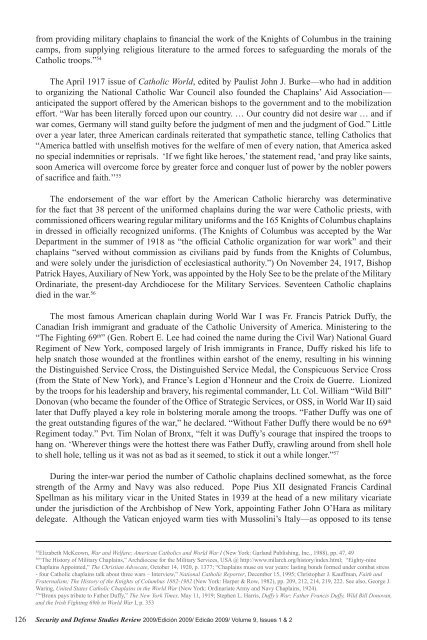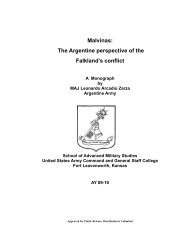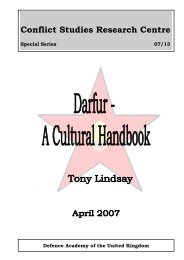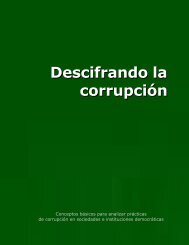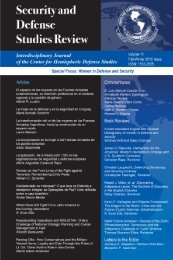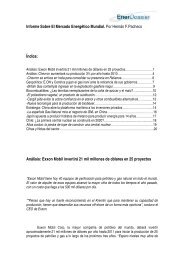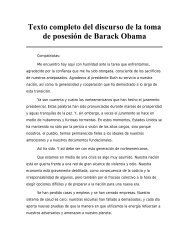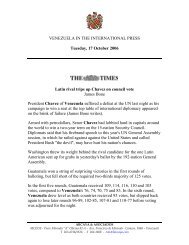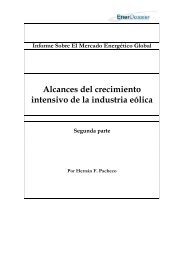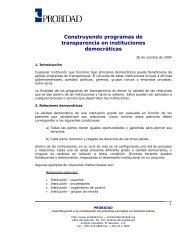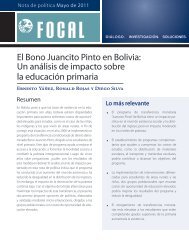from providing military chaplains to financial the work of the Knights of Columbus in the trainingcamps, from supplying religious literature to the armed forces to safeguarding the morals of theCatholic troops.” 54The April 1917 issue of Catholic World, edited by Paulist John J. Burke—who had in additionto organizing the National Catholic War Council also founded the Chaplains’ Aid Association—anticipated the support offered by the American bishops to the government <strong>and</strong> to the mobilizationeffort. “War has been literally forced upon our country. … Our country did not desire war … <strong>and</strong> ifwar comes, Germany will st<strong>and</strong> guilty before the judgment of men <strong>and</strong> the judgment of God.” Littleover a year later, three American cardinals reiterated that sympathetic stance, telling Catholics that“America battled with unselfish motives for the welfare of men of every nation, that America askedno special indemnities or reprisals. ‘If we fight like heroes,’ the statement read, ‘<strong>and</strong> pray like saints,soon America will overcome force by greater force <strong>and</strong> conquer lust of power by the nobler powersof sacrifice <strong>and</strong> faith.’’ 55The endorsement of the war effort by the American Catholic hierarchy was determinativefor the fact that 38 percent of the uniformed chaplains during the war were Catholic priests, withcommissioned officers wearing regular military uniforms <strong>and</strong> the 165 Knights of Columbus chaplainsin dressed in officially recognized uniforms. (The Knights of Columbus was accepted by the WarDepartment in the summer of 1918 as “the official Catholic organization for war work” <strong>and</strong> theirchaplains “served without commission as civilians paid by funds from the Knights of Columbus,<strong>and</strong> were solely under the jurisdiction of ecclesiastical authority.”) On November 24, 1917, BishopPatrick Hayes, Auxiliary of New York, was appointed by the Holy See to be the prelate of the MilitaryOrdinariate, the present-day Archdiocese for the Military Services. Seventeen Catholic chaplainsdied in the war. 56The most famous American chaplain during World War I was Fr. Francis Patrick Duffy, theCanadian Irish immigrant <strong>and</strong> graduate of the Catholic University of America. Ministering to the“The Fighting 69 th ” (Gen. Robert E. Lee had coined the name during the Civil War) National GuardRegiment of New York, composed largely of Irish immigrants in France, Duffy risked his life tohelp snatch those wounded at the frontlines within earshot of the enemy, resulting in his winningthe Distinguished Service Cross, the Distinguished Service Medal, the Conspicuous Service Cross(from the State of New York), <strong>and</strong> France’s Legion d’Honneur <strong>and</strong> the Croix de Guerre. Lionizedby the troops for his leadership <strong>and</strong> bravery, his regimental comm<strong>and</strong>er, Lt. Col. William “Wild Bill”Donovan (who became the founder of the Office of Strategic Services, or OSS, in World War II) saidlater that Duffy played a key role in bolstering morale among the troops. “Father Duffy was one ofthe great outst<strong>and</strong>ing figures of the war,” he declared. “Without Father Duffy there would be no 69 thRegiment today.” Pvt. Tim Nolan of Bronx, “felt it was Duffy’s courage that inspired the troops tohang on. ‘Wherever things were the hottest there was Father Duffy, crawling around from shell holeto shell hole, telling us it was not as bad as it seemed, to stick it out a while longer.” 57During the inter-war period the number of Catholic chaplains declined somewhat, as the forcestrength of the Army <strong>and</strong> Navy was also reduced. Pope Pius XII designated Francis CardinalSpellman as his military vicar in the United States in 1939 at the head of a new military vicariateunder the jurisdiction of the Archbishop of New York, appointing Father John O’Hara as militarydelegate. Although the Vatican enjoyed warm ties with Mussolini’s Italy—as opposed to its tense55Elizabeth McKeown, War <strong>and</strong> Welfare; American Catholics <strong>and</strong> World War I (New York: Garl<strong>and</strong> Publishing, Inc., 1988), pp. 47, 4956“The History of Military Chaplains,” Archdiocese for the Military Services, USA @ http://www.milarch.org/history/index.html; “Eighty-nineChaplains Appointed,” The Christian Advocate, October 14, 1920, p. 1377; “Chaplains muse on war years: lasting bonds formed under combat stress- four Catholic chaplains talk about three wars – Interview,” National Catholic Reporter, December 15, 1995; Christopher J. Kauffman, Faith <strong>and</strong>Fraternalism; The History of the Knights of Columbus 1882-1982 (New York: Harper & Row, 1982), pp. 209, 212, 214, 219, 222. See also, George J.Waring, United States Catholic Chaplains in the World War (New York: Ordinariate Army <strong>and</strong> Navy Chaplains, 1924).57“Bronx pays tribute to Father Duffy,” The New York Times, May 11, 1919; Stephen L. Harris, Duffy’s War; Father Francis Duffy, Wild Bill Donovan,<strong>and</strong> the Irish Fighting 69th in World War I, p. 353126<strong>Security</strong> <strong>and</strong> <strong>Defense</strong> <strong>Studies</strong> <strong>Review</strong> 2009/Edición 2009/ Edicão 2009/ Volume 9, Issues 1 & 2
elations with Nazi Germany—a bond that extended to the faithful in the United States, as warapproached once again the American Catholic Church was at the forefront of rallying the faithfulbehind the U.S. government. In this effort, Catholic chaplains served as the advanced guard.Already in 1936, Catholic chaplains were reported to “feel keenly” about the “frequent agitations”for “peace at any price” being promoted by the Federal Council of the Churches of Christ in America<strong>and</strong> the Church Peace Union’s call for withdrawing chaplains from the Navy <strong>and</strong> Army. On December31, 1936, Rev. George J. Waring, vicar general of the Military Ordinariate, wrote to Mon. MichaelJ. Read, general secretary of the National Catholic Welfare Conference that, “While we are opposedto war, we cannot assume that conditions will not arise that will necessitate it. … In the N.C. Newsreleases, you will be able to state the Catholic policy in reference to war <strong>and</strong> the need for chaplainsin the services, both in time of peace <strong>and</strong> war.” In May 1940, The New York Times reported that atthe 15 th annual conference of the Army Chaplains of the United States, “Army Chaplains Hear UnityPleas … Strong <strong>Defense</strong> is Backed.” Keynote speaker William Arnold, Army chief of chaplains,told the group, “It is not only a privilege <strong>and</strong> an honor to belong to an army that will save us” fromgodless totalitarianism “but it is also a religious duty.” Archbishop Francis J. Spellman warned thegathered, who included New York Governor Herbert Lehman <strong>and</strong> Mayor Fiorello LaGuardia, that:“We’ve heard of fifth, sixth <strong>and</strong> seventh columns in other countries <strong>and</strong> we know of the existence ofthem here.” Spellman added:We chaplains should concentrate on the second column—love of God <strong>and</strong> love of country. Wein the United States have good will toward all, but we should not be so good-willed as to allowthose of bad will to predominate. We should not be so democratic as to allow others to come<strong>and</strong> destroy our democracy. We should uphold <strong>and</strong> defend our freedom.Seven months later, on Veterans’ Day, Rev. O’Hara, bishop of the Military Ordinate, addressed3,500 of the faithful as a mass in St. Patrick’s Cathedral while Spellman looked on, saying, “Thegreatest service you can do your country <strong>and</strong> your God in this day is to work <strong>and</strong> pray for theconversion of the enemy from within—conversion to God <strong>and</strong> to true Americanism.” Less than twomonths before Pearl Harbor, in October 1941, the National Catholic Welfare Council was able toreport, “Priests now with the armed forces of the United States represent the largest complement ofCatholic Chaplains ever to serve in the Army, Navy <strong>and</strong> Marine Corps during peacetime in the historyof the country.” 58On the eve of U.S. participation in World War II Father Arnold, the chief of Army chaplains, sentout a “My dear Chaplain” letter to those under his comm<strong>and</strong> in which he extolled the armed forceswhose participation in the conflict was quickly approaching. “The purpose <strong>and</strong> influence of yourreligious work extend far beyond mere military training <strong>and</strong> armed defense,” Arnold wrote. “You area man of peace … in the midst of warlike surroundings. Your Government, your Army, <strong>and</strong> the menyou face in religious assemblies under tent or in open fields are all for peace. But they are compelledby the belligerent force of moral evil in the world to arm <strong>and</strong> fight for the preservation of those rights<strong>and</strong> liberties without which no peace is possible.” 5958“The History of Military Chaplains,” op., cit.; D’Agostino, op.cit., pp. 159-229, 250.; Box 57, Folder: “Military Affairs: Chaplains 1930-1939,”National Catholic Welfare Council General Administration Series, ACUA. Waring enclosed a September 23, 1933 letter from Linley V. Gordon ofthe Church Peace Union, that quoted Rev. Peter Ainslie’s book, Some Experiments in Living, that made the case for withdrawing the chaplains fromservice: “War having been outlawed by the political governments of the world, the logical step was for the denominations to withdraw their chaplainsfrom a world-outlawed institution. This one act would have done more than any other one thing to remove war from consideration among the nationsof the world.” In a September 28, 1933 response to Gordon, Waring responded: “Even if war has been outlawed by some of the Governments of theword, I cannot see that that has to do with the maintenance of a national army. An army is to the nation what the police force is to a state or city. Noone ever suggested that police forces are organized for the purpose of making war on citizens. Their chief function is to maintain peace <strong>and</strong> order intheir respective communities.”; The New York Times, May 22, 1940, p. 12.; “Enemy Conversion by Prayer Asked,” The New York Times, Nov. 11,1940, p. 14. “467 priests in service; Record peacetime complement of U.S. Catholic military chaplains,” NCWC News Service release, October 15,1941, Box 57, Folder: “Military Affairs: Chaplains 1940-1941”; National Catholic Welfare Council General Administration Series, ACUA.59NCWC/USCC General Secretary/Executive Department 100-D, “Military Affairs: War Dept.: Chief of Chaplains 1940”, ACUA.<strong>Security</strong> <strong>and</strong> <strong>Defense</strong> <strong>Studies</strong> <strong>Review</strong> 2009/Edición 2009/ Edicão 2009/ Volume 9, Issues 1 & 2 127
- Page 4 and 5:
Document: Speech on “Security, In
- Page 6 and 7:
6Security and Defense Studies Revie
- Page 8 and 9:
un tema de seguridad y defensa porq
- Page 10 and 11:
Los Intereses de la República Popu
- Page 12 and 13:
En el marco estratégico descrito e
- Page 14 and 15:
Works (FAW), Geeley, Dongfeng, y Ch
- Page 16 and 17:
interés en participar en el yacimi
- Page 18 and 19:
al emplear personas locales en todo
- Page 20 and 21:
había un banco en Colombia especia
- Page 22 and 23:
ehén de los FARC, escribe de siete
- Page 24 and 25:
estadounidenses en el futuro, y por
- Page 26 and 27:
26Security and Defense Studies Revi
- Page 28 and 29:
Existe numerosa literatura que trat
- Page 30 and 31:
La Tabla 1.1, demuestra que el apor
- Page 32:
Los cuestionamiento a este modelo d
- Page 35 and 36:
….derogaremos la Ley del Cobre y
- Page 37 and 38:
Figura 4.3.Aporte de CODELCO por ve
- Page 39:
Figura 6.Elaboración propia distri
- Page 42 and 43:
de los proyectos de defensa necesit
- Page 44 and 45:
En el caso de las inversiones en de
- Page 46 and 47:
Anexo 1PROTOCOLO DE ACUERDO QUE ACO
- Page 48 and 49:
OECD. “Models of Public Budgeting
- Page 50 and 51:
proyectos nacionales y democrático
- Page 52 and 53:
DesprofesionalizaciónEn la región
- Page 54 and 55:
Según algunos autores, “no sorpr
- Page 56 and 57:
(antinarcóticos), la Guardia Coste
- Page 58 and 59:
supervigilen las acciones intrusiva
- Page 60 and 61:
Quizás una de las fallas provenga
- Page 62 and 63:
Junto con ello se elaboró una nuev
- Page 64 and 65:
Colombia). Por otro, hay una serie
- Page 66 and 67:
Maldonado, Carlos, “Profesionalis
- Page 68 and 69:
policías y militares no ha estado
- Page 70:
La relación entre fuerzas militare
- Page 73 and 74:
dictaduras. En aquellos con más tr
- Page 75 and 76: efectos de planificación se ha hab
- Page 77 and 78: BibliografíaAguila, Ernesto y Mald
- Page 79 and 80: Sherman, Lawrence. et.al. 1973. Tea
- Page 81: Influenza Pandemic and its National
- Page 84 and 85: and restaurant services” is expec
- Page 86 and 87: The ability of the health sector to
- Page 88 and 89: BibliographyAlmond, D. and B. Mazum
- Page 90 and 91: El trabajo parte del supuesto de qu
- Page 92 and 93: es tanto una elección voluntaria c
- Page 94 and 95: Por otro lado, Rusia nunca ha visto
- Page 96 and 97: La Organización del Tratado del At
- Page 98 and 99: liquidez internacional pero tambié
- Page 100 and 101: petróleo recientemente descubierta
- Page 102 and 103: Dentro de este esquema, Estados Uni
- Page 104 and 105: 104Security and Defense Studies Rev
- Page 106 and 107: minimize a number of attempts at fo
- Page 108 and 109: kidnapping, of Maria Edith de Deber
- Page 110 and 111: The political campaign that resulte
- Page 112 and 113: would carry out the more violent ta
- Page 114 and 115: of the EPP so far, is the relative
- Page 117 and 118: to accept ideas, policies or course
- Page 119 and 120: eing killed themselves—the idea t
- Page 122 and 123: In Latin America, the role played b
- Page 124 and 125: the Church to be given to the dying
- Page 128 and 129: Perhaps one of the clearest example
- Page 130 and 131: was prepared by the Office of the C
- Page 132 and 133: 132Security and Defense Studies Rev
- Page 135 and 136: Keynote Speech by Dr. Frank O. Mora
- Page 137 and 138: If successful, these infrastructure
- Page 139 and 140: Security, Intelligence and the Role
- Page 141 and 142: Clearly, security, intelligence and
- Page 143 and 144: Contratapa(Contratapa offers, in a
- Page 145 and 146: efforts have become intertwined; fo
- Page 147 and 148: comprensión de sus valores y cultu


